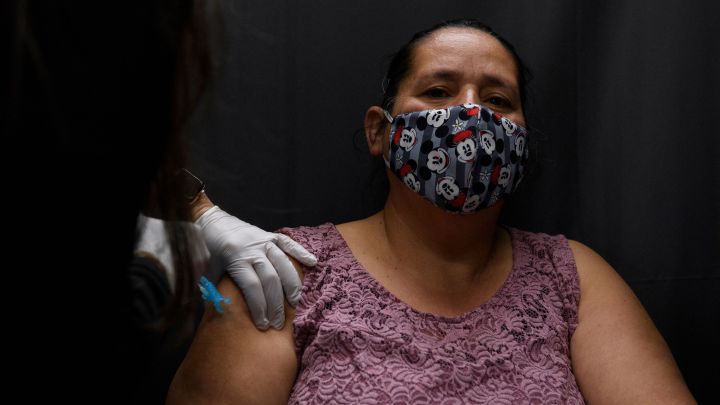
Rural Washington confronts vaccine disparity for its Latinx workforce
Rural Washington confronts vaccine disparity for its Latinx workforce

The COVID-19 hospitalization rate among Latinx Americans is three times the rate of white Americans. There are lots of reasons for the disparity, including poverty, language barriers and discrimination. And many Latinx people perform essential jobs — in agriculture and food processing, for instance, where there have been big outbreaks of the novel coronavirus.
And now that the country is getting vaccinated at a rapid clip, the disparity persists: The Latinx population is getting vaccinated at a slower pace than other Americans. According to recent data compiled by the American Public Media Research Lab, 21.3% of the white population nationwide has been vaccinated, compared with 11.3% of Latinx people and 12.7% of Black people.
The Yakima Valley, one of Washington state’s most productive farming regions, demonstrates how this disparity is playing out at the local level.
The city of Yakima has crowded neighborhoods of mobile homes and bodegas advertising tacos and Mexican sweets. The surrounding countryside rolls across orchards and fields, and big fruit-packing warehouses line the dusty highways.
For the past several weeks, the city’s convention center has turned into a COVID-19 vaccination center, run by the Yakima Valley Farm Workers Clinic, a locally based network of health centers that serves low-income, predominantly Latinx communities in Washington and Oregon..

Seventy-eight-year-old Angelina Gallegos was waiting outside recently to get temperature-checked before entering the center.
“I came to get my vaccine,” Gallegos said. “It’s a blessing from God.” She said she wasn’t afraid to get vaccinated.
Her son, who works in the fields, got COVID-19 last year, along with his wife.
“My son Tino was put in the hospital,” Gallegos said. “It started with a high fever, swelling, and his throat was badly infected.”
“In the beginning of the vaccination efforts, we did have challenges with receiving vaccine,” said nurse Lori Kelley, senior director of quality at the Yakima Valley Farm Workers Clinic. According to Kelley, local essential workers in food-processing and agriculture, most of them Latinx, had to wait for months to be vaccinated, even though they’ve suffered high rates of COVID-19 illness and death since the outbreak of the pandemic.
Kelley said that vaccinations are now picking up. Essential workers have become eligible for vaccination, as well as some people living in multigenerational households. And, in March, the clinic began receiving more vaccine doses through a federal pilot program for safety-net community health centers run by the Health Resources and Services Administration.
“That collaboration has allowed us to have a steady supply of vaccines to provide to our communities,” Kelley said. “Sometimes the only vaccine we receive in a given week is our HRSA vaccine.”
But there is still a long way to go to redress racial and ethnic disparities in vaccination, said Samantha Artiga, director of the Racial Equity and Health Policy Program at the Kaiser Family Foundation.
“Hispanic people are receiving smaller shares of vaccinations, relative to their shares of cases, deaths and total population,” Artiga said. “White people were nearly twice as likely to be vaccinated as Hispanic people.”
In Washington state, just 7% of people who’ve been vaccinated are Latinx, though they make up 13% of the state’s population, according to data from the state Department of Health.
Part of the reason may be that more white residents are elderly and qualified earlier, according to county health officials. But Artiga said there are other reasons for the low Latinx vaccination rate: “Hispanic people report more challenges getting to locations for health care, they may also face linguistic barriers to care. They also are less likely to be connected to a health care provider because they are more likely to be uninsured.”

Knowing that the vaccine would be free and wouldn’t require insurance helped convince Julieta Pulido to get vaccinated at her local clinic in Yakima. She is 32 and works in a fruit-packing warehouse where dozens of workers got sick last year, prompting a walkout.
“It hit home,” she said. “One of my close friends, she got COVID. You know, it was scary because I was sitting next to her all the time.”
Pulido was pregnant at the time. Now she has a 5-month old — another reason to get vaccinated.
“I thought to myself, ‘I have a child, and I have to be healthy and safe for her. And if it’s available now, why not take it?’”
Kelley at the Yakima Valley Farm Workers Clinic said that with spring here, workers in the fields and packing plants across the region are about to get very busy.
“We have worked with some of our agricultural growers to offer on-site vaccinations for their employees,” she said. “And thus far we have found that those workers are very interested in getting the vaccine.”
Meanwhile, the Federal Emergency Management Agency, state and local health departments, and Yakima Valley Memorial Hospital have just opened a federally supported mass drive-through vaccination center at the county fairgrounds.
There’s a lot happening in the world. Through it all, Marketplace is here for you.
You rely on Marketplace to break down the world’s events and tell you how it affects you in a fact-based, approachable way. We rely on your financial support to keep making that possible.
Your donation today powers the independent journalism that you rely on. For just $5/month, you can help sustain Marketplace so we can keep reporting on the things that matter to you.












